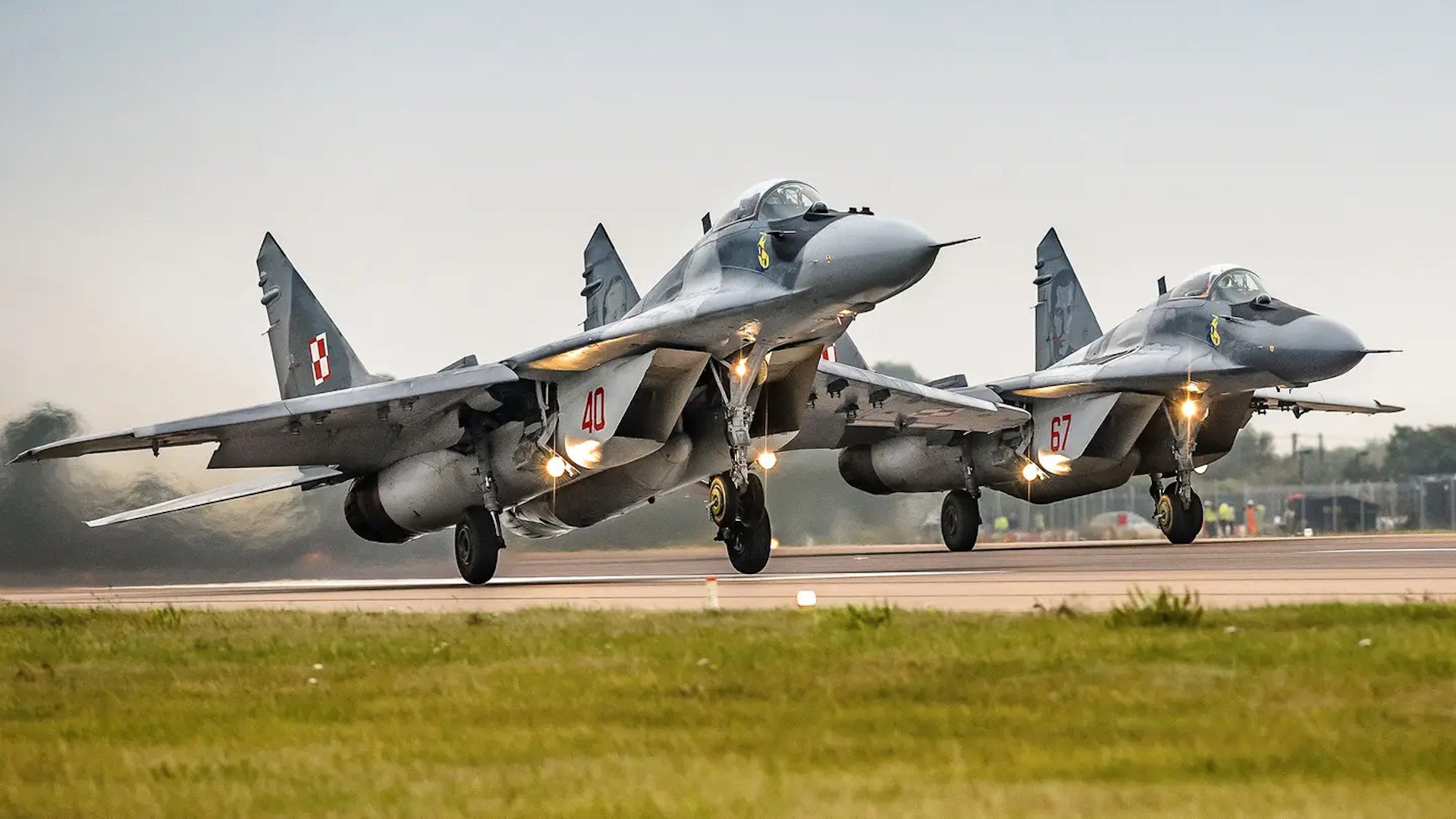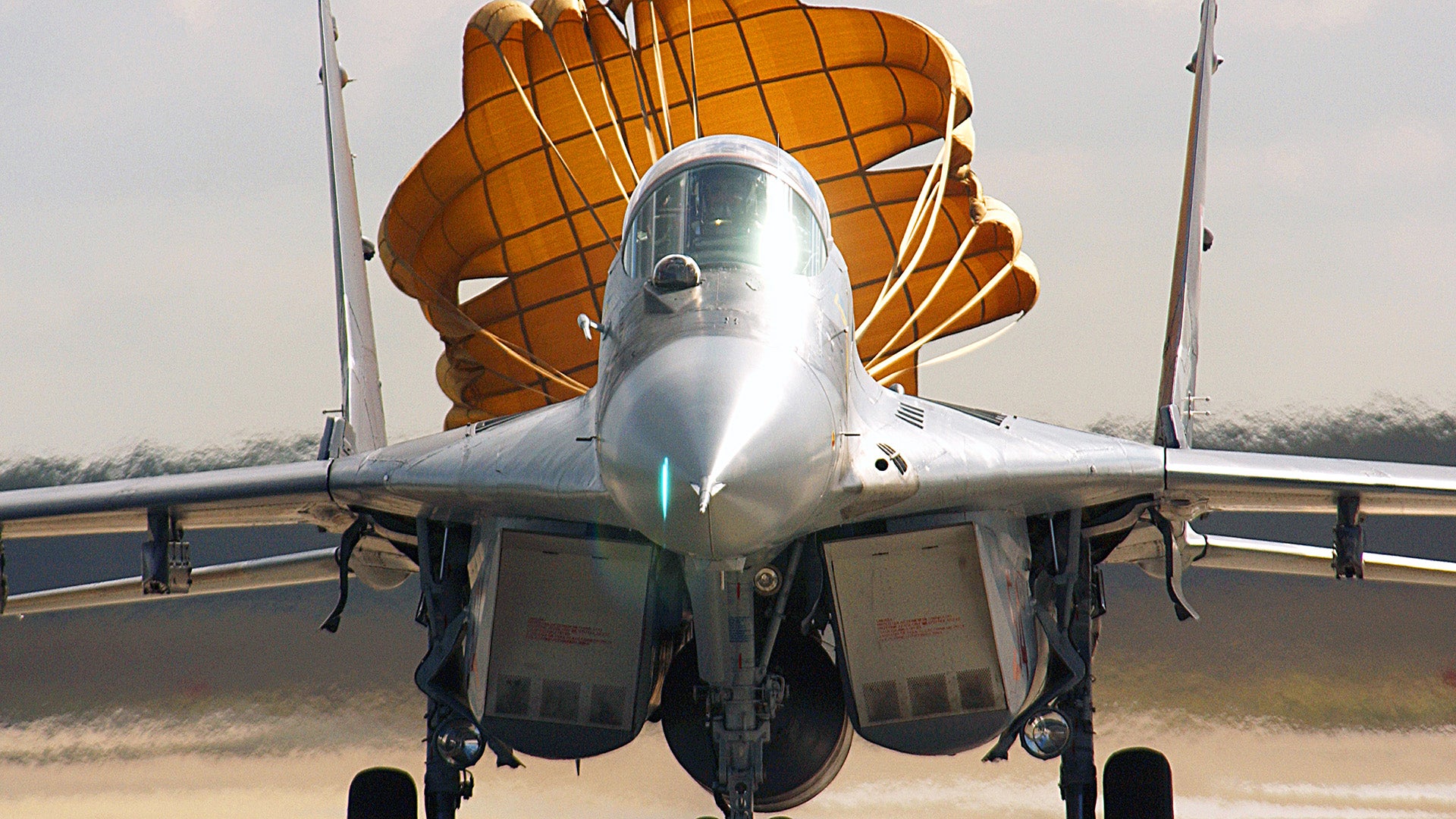After multiple carefully worded denials regarding reports about planned sales or donations of MiG-29 Fulcrum fighter jets to Ukraine, the Polish government has formally announced plans to transfer its entire fleet of these aircraft to the U.S. government. Though not stated, it seems all but certain that American authorities will pass these jets to the Ukrainian Air Force. Secretary of State Antony Blinken said this past weekend that such a transfer would, unequivocally, get a "green light" from the United States.
The Pentagon has now issued its own carefully worded statement in response to the Polish government's announcement, which you can find in an update at the bottom of this story.
The Polish Ministry of Foreign Affairs announced the deal today, adding that it had requested the U.S. government provide sufficient numbers of other fighter jets to make up for the loss of these MiG-29s. The Polish Air Force's current fighter jet fleets consist of around 28 Fulcrums and some 48 Block 52+ F-16C/D Vipers. In terms of combat jets, Poland's Air Force also operates a smaller number of Su-22M4 Fitter ground-attack jets. The country also has F-35A Joint Strike Fighters on order, but does not expect to take delivery of the first one of these jets until 2024.

"The authorities of the Republic of Poland, after consultations between the President and the Goverment, are ready to deploy – immediately and free of charge – all their MiG-29 jets to the Ramstein Air Base and place them at the disposal of the Government of the United States of America," the Polish Foreign Ministry's statement reads. "At the same time, Poland requests the United States to provide us with used aircraft with corresponding operational capabilities. Poland is ready to immediately establish the conditions of purchase of the planes."
The title of the press release, which does not mention Ukraine at all, adds that this is "in connection with the statement by the US Secretary of State." This is all but certainly a reference to Blinken's comments regarding the transfer of fighter jets from Poland to Ukraine.
“We are looking actively now at the question of airplanes that Poland may provide to Ukraine and looking at how we might be able to backfill should Poland decide to supply those planes,” Blinken told reporters on Sunday during his visit to Moldova. “I can’t speak to a timeline but I can just say we’re looking at it very, very actively.”
Blinken had separately said in an interview with CBS News' "Face The Nation" that the U.S. government did not see transferring fighter jets to Ukraine as an escalation of its involvement in the conflict there. He added that if the Polish did decide to turn over their MiG-29s to the Ukrainians that such a plan would get a "green light" from American officials.
There had also previously been unconfirmed reports that Ukrainian pilots were already in Poland preparing to take custody of the country's MiG-29s. However, Poland had publicly rejected the idea of transferring any aircraft to Ukraine, as well as reports that it might allow Ukrainian jets to fly from its bases. It now appears that these prior statements were very carefully crafted to be technically accurate while negotiations for how the transfer might be affected were still ongoing.
Despite Blinken's previous comments, any transfer of MiG-29s from any NATO country is likely to draw a rebuke of some kind from Russia. Poland's desire to try to avoid that backlash is likely a key factor in its choice to hand the jets over to the U.S. government first. It's not clear if American officials, who have been pressing their Polish counterparts over this matter, were aware that authorities in Warsaw would propose this particular diplomatic maneuver.
"To my knowledge, it wasn't pre-consulted with us that they planned to give these planes to us," Victoria Nuland, Under Secretary of State for Political Affairs, said at a hearing today when asked about the Polish government's plans. "I look forward when this hearing is over to getting back to my desk and seeing how we will respond to this proposal of theirs to give the planes to us."
In addition, the Polish Ministry of Foreign Affair's statement today ends with an appeal to "other NATO Allies – owners of MiG-29 jets – to act in the same vein." There had also been reports that Bulgaria and Slovakia might transfer their Fulcrums to Ukraine. There was discussion about Bulgaria possibly giving up its Soviet-designed Su-25 Frogfoot ground-attack aircraft, as well.
Officials in both of those countries have also denied those reports, but the Polish government's decision raises questions about whether similar transfers to the U.S. government first are actually in the works or could be in the near future. At the same time, as The War Zone has previously explored in depth, for Bulgaria and Slovakia, giving their jets to Ukraine would mean ceding their own organic combat aviation capabilities for at least a number of years. This could make it more difficult for these countries to agree to such a plan, even with promises that the U.S. government help backfill at least some of that capacity.
Dozens of additional combat jets would be an obvious boon for the Ukrainian armed forces, which started out the conflict at a severe numerical disadvantage to the Russian military, especially in combat jets. The Ukrainian Air Force has been able to prevent Russia from gaining air superiority after nearly two weeks in no small part thanks to the aircraft it does have, but its fleets have suffered losses as the fighting has dragged on. The U.S. military has assessed that Russian forces are now working to expand deployments of surface-to-air missile systems to try to help change the balance of power.
There are still numerous questions about how any transfer of ex-Polish MiG-29s to Ukraine will actually be carried out, as well as what other fighters Poland's Air Force might now be in line to buy. The underlying idea behind giving Ukraine the Fulcrums, as well as the Frogfoots, is that the country's Air Force already operates these jets, which would hopefully make it easier for them to absorb additional examples.
However, Poland's MiG-29s, though originally built during the Soviet era, have been substantially upgraded over the years and are much more advanced than Ukraine's examples. Beyond that, the cockpit layout of these aircraft is substantially different from the types that the Ukrainian Air Force has in inventory now. While it might not be necessary to train Ukrainian pilots to use all of the features found on the Polish fighters for them to take the aircraft in combat, some amount of instruction will be necessary.
There are also certain NATO-specific or otherwise sensitive systems that will need to be removed from the aircraft first. Any sort of demodification process would take some amount of time.
In addition, the basic logistics of getting the planes to Ukraine look set to be complicated. Currently, the U.S. government is not flying weapons and other military aid to Ukraine directly. Instead, planes bring it to facilities in Poland and Romania where the cargo is then loaded onto trucks for transport overland. Breaking down 28 MiG-29s, loading them onto trucks, driving them to Ukraine, and then reassembling the aircraft sounds like a process that could easily be arduous.
There is a possibility that Ukrainian pilots could come to Ramstein Air Base in Germany, or wherever the Polish jets might eventually end up, and then fly them back to Ukraine. The Ukrainian Air Force recently arranged to fly a Su-27 Flanker fighter jet that had been forced to land in Romania under still unclear circumstances earlier in the conflict back home. In that case, Romanian MiG-21s escorted the very clearly unarmed Flanker to the border with Ukraine.
Ukraine does claim to have pilots ready to jump in the cockpits of these jets once they arrive. Whether it has sufficient maintenance personnel and supply chains to support them is another question. The Polish Air Force established dedicated supply chains to support these jets.
It's also unclear what "used aircraft with corresponding operational capabilities" Poland might hope to receive from the U.S. government. As The War Zone
has previously explained, the U.S. military has only a limited number of F-16C/D aircraft that are comparable to Vipers that the Polish Air Force has and these aircraft are important parts of the U.S. Air Force's current force structure. Authorities in Warsaw could potentially accept older Air Force F-16C/Ds, some of which are being steadily upgraded to much more modern standards now.

Another way to mitigate this lost capability could be the U.S. government, as well as other NATO members, offering to deploy their own fighter jets to Poland on a rotational basis to help defend the country's skies for at least some number of years. Multiple nations within the alliance have already deployed fighter jets to locations across its eastern periphery with Russia in recent months in light of the situation surrounding Ukraine.
All told, it will be interesting to see what will happen to Poland's MiG-29s and what their future in Ukrainian service might look like in the end.
Update 6:55 PM EST:
Pentagon Press Secretary John Kirby has now issued a statement regarding the Polish announcement. His full response is as follows:
It's important to note that what Kirby appears to be primarily objecting to is the possibility of U.S. military pilots flying these jets to Ukraine, either to deliver them or for some other purpose, which is indeed untenable. From what Russian officials have said since the invasion began, they would almost certainly view the U.S. government as having become a party to the conflict if it flew ex-Polish MiGs into Ukrainian airspace.
It's not immediately clear from Kirby's statement if the U.S. government has entirely ruled out the idea of serving as some kind of intermediary for a transfer of the jets to Ukrainian custody at a location outside of Ukraine.
Update 3/9/2022:
The Polish government has now made clear that its proposal yesterday was both intended as an intermediate step toward transferring its MiG-29s to Ukraine and that this was meant to reduce potential direct risks to the country. Russia has, as expected, warned Poland or any other NATO member against delivering these jets to the Ukrainian Air Force.
"Such a serious decision as supplying planes must be unanimous and unequivocally made by the whole North Atlantic alliance," Polish Prime Minister of Mateusz Morawiecki said during a press conference on March 9, 2022. "We did not agree to supply planes by ourselves, because it must be the decision of the whole of NATO."
"It cannot be that Poland has – as the only NATO country – to take the risk, and the other countries would not have to compensate or share it with us in any way," Polish Deputy Foreign Minister Pawel Jablonski said in a separate radio interview, also on March 9.
Update:
The Pentagon has now come out and said that it will not support Poland's proposed transfer of the MiG-29s for a number of reasons including fears that it could provoke serious retaliation from Russia. You can read more about this and other related developments here.
Contact the author: [email protected]









